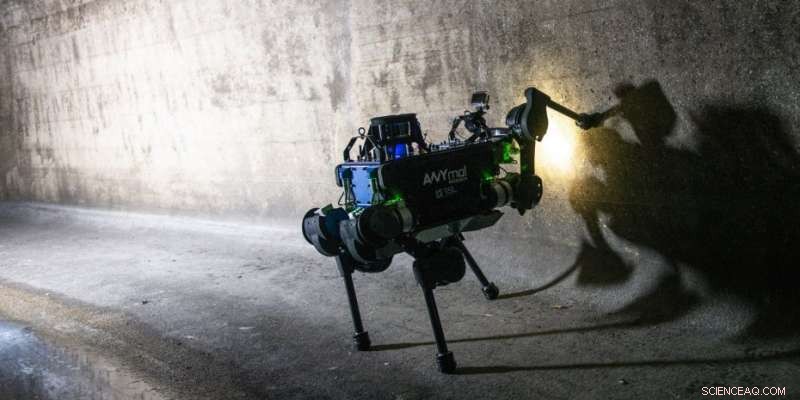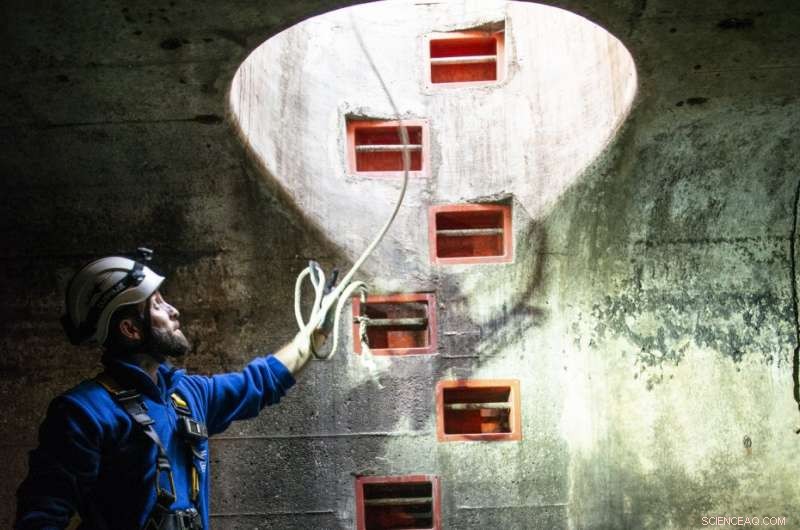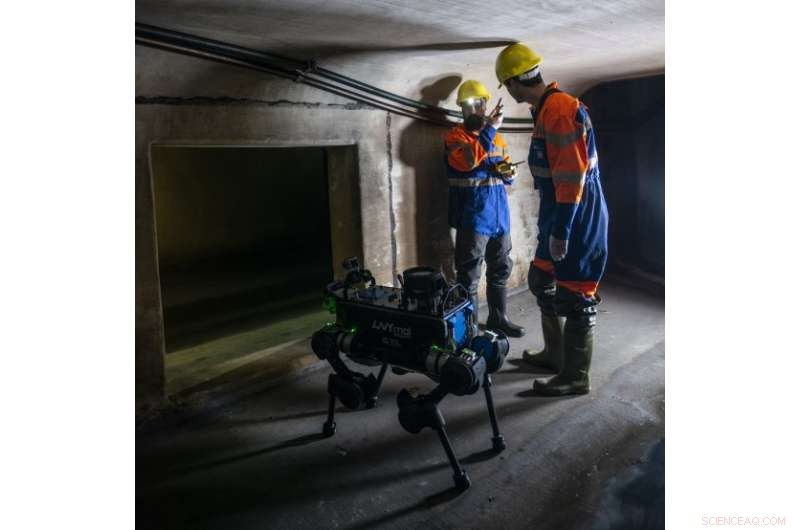
ANYmal lors de sa première tournée d'inspection dans le réseau d'égouts de Zurich. Crédit :ETH Zurich / Daniel Winkler
N'IMPORTE QUELLE, un robot développé à l'ETH, peut voir et entendre, et même des portes ouvertes. Une équipe de recherche internationale travaille maintenant pour s'assurer que le robot peut fonctionner dans des conditions extrêmes - une mission qui les emmène dans le labyrinthe de drains et de tunnels sous Zurich.
Deux hommes soulèvent la machine high-tech de 30 kilogrammes et l'abaissent dans le puits sombre à l'aide d'une corde. On met des salopettes réfléchissantes, troquez nos chaussures contre des cuissardes en caoutchouc et attachez-les fermement à nos tenues. Puis vient un casque, une lampe de poche et des gants jetables pour chacun de nous. Entièrement équipé, nous commençons notre descente, en suivant les marches le long de la paroi du puits une à une jusqu'à ce que nous atteignions le système d'égouts de Zurich, quatre mètres sous la surface.
En cette chaude journée d'automne, une équipe de chercheurs effectue des tests sous terre. Leur objectif est de déterminer si ANYmal - un robot développé conjointement par Robotic Systems Lab et ANYbotics, spin-off de l'ETH – pourrait un jour être déployé dans les réseaux d'assainissement. Il peut être utilisé, par exemple, pour aider les employés de la ville de Zurich qui doivent régulièrement marcher ou ramper à travers les quelque 100 kilomètres de puits et de canalisations accessibles sous la ville et dont le travail consiste à vérifier les murs et les sols pour les dommages. Ce travail présente non seulement un risque pour la santé, mais est aussi potentiellement mortelle, étant donné que les drains peuvent se remplir d'eau très rapidement sans avertissement. Un autre avantage des robots dans un tel environnement est qu'ils pourraient fonctionner dans des égouts étroits qui ne sont pas accessibles avec la technologie utilisée aujourd'hui.
Test initial
Les chercheurs placent le robot debout au fond du puits. Il mesure environ 50 cm de haut et possède quatre pattes articulées ainsi qu'un objet ressemblant à une tête composé d'une caméra et de divers capteurs.
Peter Fankhauser, co-fondateur de la spin-off ETH qui commercialise ANYmal, radios ses collègues en surface, qui sont chargés de coordonner le test et d'envoyer des commandes au robot. Fankhauser tourne alors avec un joystick et le robot avance péniblement. Comme il s'agit du premier essai en terrain inconnu, il prend le contrôle partiel du robot même s'il est capable de se déplacer de manière autonome. "C'est une mesure de précaution, " dit Fankhauser, « Ce n'est pas parce que quelque chose fonctionne en laboratoire que cela fonctionnera dans le monde réel. » Après tout, les conditions souterraines ne sont pas celles auxquelles le robot est habitué :la chambre est humide et glissante, avec des températures plus basses et une humidité plus élevée qu'en laboratoire. Quoi de plus, il est très, très sombre.
"Il est difficile de distinguer grand-chose ici, " dit Fankhauser, presque avec une pointe de résignation dans la voix, alors que le robot se déplace à un rythme lent à travers le tunnel d'environ trois mètres de haut et cinq mètres de large. Le robot émet un son électromécanique uniforme – une sorte de vrombissement rythmique – qui se mélange au bruit de l'eau qui jaillit de l'égout principal à proximité. Nous sommes dans un égout à débordement assez grand avec seulement un filet d'eau dedans. Étant donné que le robot en est à son premier essai à quatre mètres sous le niveau du sol, les chercheurs ont pris la précaution d'éviter les gros volumes d'eau.

Les ouvriers manœuvrent soigneusement le robot de haute technologie dans le puits étroit. Crédit :ETH Zurich
Trouver son chemin dans le noir
Le projet de recherche triennal THING (sub-Terranean Haptic InvestiGator) a pour objectif de concevoir des robots capables de se déplacer seuls et de mieux identifier leur environnement. Les robots utilisent généralement des caméras 3D et des capteurs laser pour l'orientation. Mais de tels dispositifs peuvent mal fonctionner dans des conditions défavorables, par exemple lorsque la surface du sol est humide ou l'air chargé de poussière. C'est pourquoi les chercheurs considèrent la perception haptique améliorée – l'orientation par le toucher – comme une solution possible. Le projet a réuni des chercheurs de l'ETH avec des collègues d'universités d'Édimbourg, Pise, Oxford et Poznan.
Toutes ces institutions expérimentent avec ANYmal robots, et les participants au projet des différents sites se rencontrent régulièrement. En plus des tests dans le système d'assainissement, l'année prochaine, les chercheurs déploieront le robot dans une mine de cuivre polonaise. Cela déterminera s'il peut fonctionner dans un microclimat entièrement différent, un caractérisé par chaud, les surfaces d'air et de gravier poussiéreux. L'ETH est représenté dans le projet par le Laboratoire de systèmes robotiques dirigé par le professeur Marco Hutter, qui mène des recherches sur les robots à pattes depuis de nombreuses années. He received support from ETH soon after embarking on this research in the form of an ESOP scholarship and a Pioneer fellowship.
One of the key questions on this first day of testing is whether the robot can find its way around at all in the darkness of the sewerage system. Initialement, two helpers with big LED lamps illuminate the surroundings so that we can clearly see what's going on. Puis, Fankhauser asks the helpers to turn off the lamps and radios his colleagues on the surface to tell the robot to use its own lights. The robot's sense of touch isn't the only thing that helps it find its way in the dark, as Hutter explains:"The robot uses laser sensors and cameras to scan its surroundings. By identifying irregularities in the surface of the concrete, it can determine where it is at any given moment."
All that can be seen in the darkness now are the small round LEDs in the robot's "head". The atmosphere is other-worldly:the darkness, the sound of rushing water, the electromechanical whirring, the robot's LED eyes. Then someone breaks the eerie silence momentarily with a droll comment:"Its eyes are a bit like a Rottweiler."
Underground and offshore
Researchers at ETH have been working on quadrupedal robots since 2009. The first ANYmal prototype was completed in 2015 and, one year later, ETH established the spin-off ANYbotics. The fledgling company's mission is to make robots deployable in all types of terrain so that they can be used in a wide range of practical applications. The company's slogan is "Let Robots Go Anywhere". On-site tests are carried out two or three times a month. Par exemple, Fankhauser and some members of his team recently headed to an offshore platform in the middle of the North Sea. The hope is that robots could one day perform inspections on such platforms. On its pilot run at least, ANYmal autonomously completed several inspection routes with flying colours.

ANYmal can enter spaces too small for humans. Credit:ETH Zurich
After almost ten years of research, there's a lot ANYmal can do. It can not only walk autonomously, but also boasts the sensory capabilities of sight, hearing and touch. These enable it, par exemple, to read the air pressure display on a machine, identify sounds and recognise objects – for example to determine whether or not a fire extinguisher is in the right place. The robot can even perform certain manual tasks on its own. Equipped with an additional gripping arm, it can open doors, dispose of refuse or press a lift button. It also delivers data that is more precise than our own eyes, ears and noses can perceive. It can identify the ambient temperature and detect the presence of gases in the air. Its latest trick is recognising the composition of the ground beneath it. "Some of its powers are superhuman, " says Fankhauser.
Despite the lack of light in the sewer, the robot seems to be finding its way quite well, plodding through the shallow channel at a leisurely pace. When the high-tech machine reaches a 20-centimetre-high ledge in a dry side arm of the sewer, Fankhauser brings it to a halt with a flick of the joystick. Initialement, he is reluctant to give the robot the command to climb over the ledge. Although it has easily mastered this manoeuvre in laboratory conditions, down here it is a risky undertaking. "It's an expensive machine, " says Fankhauser. But he gives it a try anyway. ANYmal doesn't manage it at its first attempt. It stops at the ledge like a horse balking at a jump. "Default, start again, " radios Fankhauser. Now the robot elegantly places one leg after another over the ledge.
Huge data volumes
While Fankhauser and Hutter watch the robot continue on its patrol for a while, I return to the surface via the entry shaft. Sitting on a bench under a white canopy, their eyes firmly fixed on a laptop, are two assistants from ETH.
A generator is buzzing and a router is blinking – and many a cyclist passing by along the main road looks on in bemusement at the hubbub around the open manhole at the side of the road. Looking over the researchers' shoulders, I can see an almost constant stream of data flickering across the screen. And thanks to state-of-the-art 3-D and laser technologies, live images constantly transmitted by the robot from underground are visible on a separate monitor.
When Fankhauser radios from below that he wants the robot to touch the wall of the sewer with one of its legs, the two assistants have their work cut out for them. The software they are using has not been programmed for this. They respond quickly, cependant, taking an algorithm originally programmed to teach ANYmal to shake hands. But to make sure the robot doesn't hit the wall with force, the researchers have to adapt the parameters. Dans ce cas, the problem is the angle at which the robot is to raise its leg. One of the assistants types in 100 and then gradually ratchets up the number. At 180 the perfect level is reached and the robot's manoeuvre is successful.
Fankhauser and Hutter emerge from the cool, humid environment of the sewerage system into the warm autumn sunshine. They slowly begin to relax as they take off their reflective overalls. "The robot was in non-stop operation and collected a lot of data, " says Fankhauser as he undoes his high rubber boots and removes his protective clothing. Professor Hutter is satisfied, too:"All the teams will be taking home a huge volume of data to incorporate in their research." They are now one step closer to their goal of delivering a robot that can function properly in challenging conditions underground. But their work is far from finished. The robot recorded 500, 000 measurements per second over the course of the day. "That's enough data to keep us busy for six months, " says Fankhauser with a laugh.